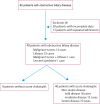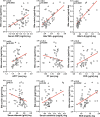Elevated plasma and bile levels of corisin, a microbiota-derived proapoptotic peptide, in patients with severe acute cholangitis
- PMID: 38037145
- PMCID: PMC10688013
- DOI: 10.1186/s13099-023-00587-4
Elevated plasma and bile levels of corisin, a microbiota-derived proapoptotic peptide, in patients with severe acute cholangitis
Abstract
Background: Acute cholangitis is a severe, life-threatening infection of the biliary system that requires early diagnosis and treatment. The Tokyo Guidelines recommend a combination of clinical, laboratory, and imaging findings for diagnosis and severity assessment, but there are still challenges in identifying severe cases that need immediate intervention. The microbiota and its derived products have been implicated in the pathogenesis of acute cholangitis. Corisin is a microbiome-derived peptide that induces cell apoptosis, acute tissue injury, and inflammation. This study aimed to evaluate the potential of plasma and bile corisin as a biomarker of acute cholangitis.
Methods: Forty patients with acute cholangitis associated with choledocholithiasis or malignant disease were enrolled. Nine patients without acute cholangitis were used as controls. Corisin was measured by enzyme immunoassays in plasma and bile samples. Patients were classified into severe and non-severe groups. The associations of plasma and bile corisin with the clinical grade of acute cholangitis and other parameters were analyzed by univariate and multivariate regression analysis.
Results: Plasma and bile corisin levels were significantly higher in patients with acute cholangitis than in controls. Patients with severe acute cholangitis had significantly higher plasma and bile corisin levels than those with non-severe form of the disease. Bile corisin level was significantly correlated with markers of inflammation, coagulation, fibrinolysis, and renal function. Univariate analysis revealed a significant association of bile corisin but a weak association of plasma corisin with the clinical grade of acute cholangitis. In contrast, multivariate analysis showed a significant relationship between plasma corisin level and the disease clinical grade. The receiver operating characteristic curve analysis showed low sensitivity but high specificity for plasma and bile corisin to detect the severity of acute cholangitis. The plasma and bile corisin sensitivity was increased when serum C-reactive protein level was included in the receiver operating characteristic curve analysis.
Conclusions: Overall, these findings suggest that plasma and bile corisin levels may be useful biomarkers for diagnosing and monitoring acute cholangitis and that corisin may play a role in the pathophysiology of the disease by modulating inflammatory, coagulation and renal pathways.
Keywords: Acute cholangitis; Apoptosis; Choledocholithiasis; Corisin; Dysbiosis; Microbiota.
© 2023. The Author(s).
Conflict of interest statement
E.C.G. and T.Y. received a Research Grant from Takeda Foundation. None of the other authors declared any competing interest regarding the data reported in this manuscript.
Figures






Similar articles
-
Role of microbiota-derived corisin in coagulation activation during SARS-CoV-2 infection.J Thromb Haemost. 2024 Jul;22(7):1919-1935. doi: 10.1016/j.jtha.2024.02.014. Epub 2024 Mar 5. J Thromb Haemost. 2024. PMID: 38453025
-
A Microbiome-Derived Peptide Induces Apoptosis of Cells from Different Tissues.Cells. 2021 Oct 26;10(11):2885. doi: 10.3390/cells10112885. Cells. 2021. PMID: 34831108 Free PMC article.
-
Verification of Tokyo Guidelines for diagnosis and management of acute cholangitis.J Hepatobiliary Pancreat Sci. 2012 Jul;19(4):487-91. doi: 10.1007/s00534-011-0464-8. J Hepatobiliary Pancreat Sci. 2012. PMID: 22033865
-
[Acute cholangitis: imaging diagnosis and management].J Radiol. 2006 Apr;87(4 Pt 2):430-40. doi: 10.1016/s0221-0363(06)74025-2. J Radiol. 2006. PMID: 16691174 Review. French.
-
Acute Bacterial Cholangitis.Viszeralmedizin. 2015 Jun;31(3):166-72. doi: 10.1159/000430965. Epub 2015 Jun 11. Viszeralmedizin. 2015. PMID: 26468310 Free PMC article. Review.
Cited by
-
Biliary HMGB1 levels and biochemical indices in the assessment of acute obstructive septic cholangitis combined with septic shock.Clinics (Sao Paulo). 2025 Mar 6;80:100611. doi: 10.1016/j.clinsp.2025.100611. eCollection 2025. Clinics (Sao Paulo). 2025. PMID: 40054422 Free PMC article.
-
Microbiota-derived corisin accelerates kidney fibrosis by promoting cellular aging.Nat Commun. 2025 Aug 25;16(1):7591. doi: 10.1038/s41467-025-61847-2. Nat Commun. 2025. PMID: 40855053 Free PMC article.
-
Exploratory Evaluation of Circulating Microbiota-Derived Corisin Levels in Women with Adverse Pregnancy Outcomes.Antioxidants (Basel). 2025 May 31;14(6):670. doi: 10.3390/antiox14060670. Antioxidants (Basel). 2025. PMID: 40563304 Free PMC article.
-
Aldehyde-based Activation of C2α-lactylthiamin Diphosphate Decarboxylation on Bacterial 1-deoxy-d-xylulose 5-phosphate Synthase.Chembiochem. 2024 Dec 2;25(23):e202400558. doi: 10.1002/cbic.202400558. Epub 2024 Nov 6. Chembiochem. 2024. PMID: 39268973
References
Grants and funding
LinkOut - more resources
Full Text Sources
Research Materials

